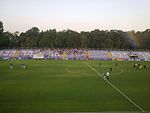Ramat Ef'al
1947 establishments in Mandatory PalestineFormer kibbutzimPopulated places established in 1947Ramat Gan

Ramat Ef'al (Hebrew: רָמַת אֶפְעַל) is a neighborhood of Ramat Gan in central Israel. Previously part of Ef'al Regional Council, in 2007 it was transferred to the municipality of Ramat Gan together with Kfar Azar.
Excerpt from the Wikipedia article Ramat Ef'al (License: CC BY-SA 3.0, Authors, Images).Ramat Ef'al
Geographical coordinates (GPS) Address Nearby Places Show on map
Geographical coordinates (GPS)
| Latitude | Longitude |
|---|---|
| N 32.043888888889 ° | E 34.834722222222 ° |
Address
5262657 , Ramat Efal
Tel Aviv District, Israel
Open on Google Maps










